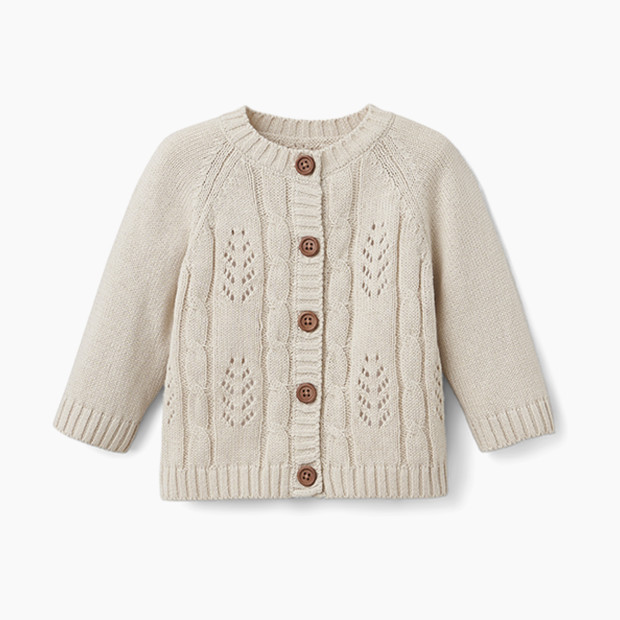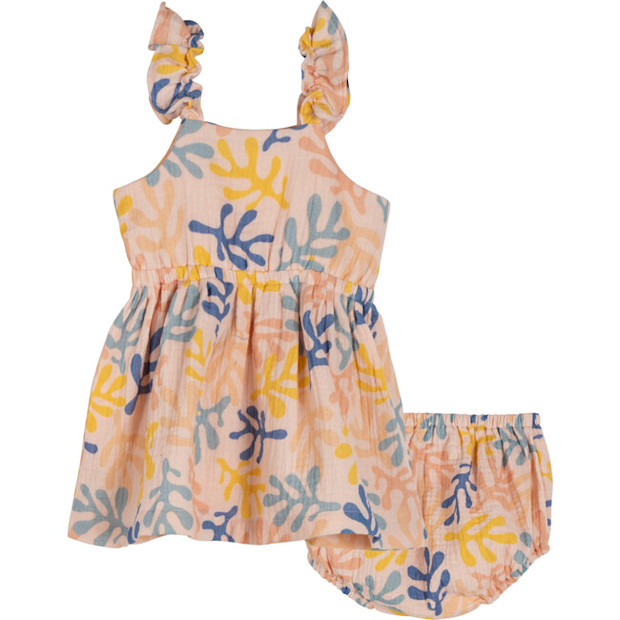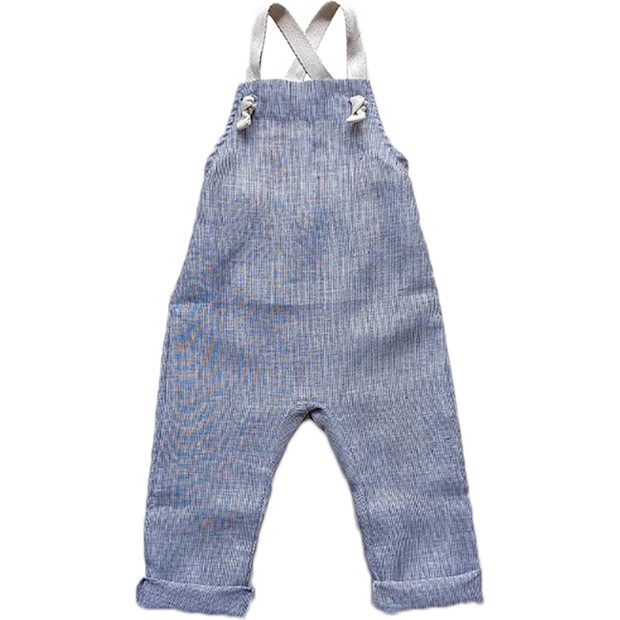
How to Buy Baby Clothes as Gifts: Shopping Tips for Fast-Growing Infants
Babies grow quickly, and finding the right sizes for the right seasons can be tricky. We're here to help.

In This Article
There are few things more fun than buying baby clothing gifts for a new baby. With countless adorable baby clothes to choose from, it can be hard to resist buying every tiny newborn outfit you come across. While you may want to scoop up as many as your arms can carry, as a gift-giver you actually have to be a little more strategic. “Parents are usually stocking up on essentials like basic, everyday bodysuits, but grandparents get to buy the fun stuff like the special occasion outfits and the photo-worthy looks,” says Dr. Danelle Fisher MD, Chair of Pediatrics at Providence Saint John’s Health Center in Santa Monica, CA. “The key is to make sure the pieces you buy will actually fit the baby, whether they’re meant to wear now or down the road.”
It can be a risk to veer away from the baby clothes parents have registered for. Clearly, you don’t want already-overwhelmed parents to have to make exchanges, nor do you want to see that picture-perfect ensemble go to waste because it's too small for the fast-growing baby. With that in mind, we asked the experts for their best baby clothing buying tips.
How to Buy Baby Clothes Gifts
Purchase Some Baby Clothes For Now…but Mostly Later
Of course, when you’re buying cute baby outfits, you may want to see the baby wearing them right away. You can do that, but you’ll also want to think ahead. “If buying multiple pieces, I prefer to buy something sweet and classic for the baby to wear now (like an exceptionally soft footie or special one-piece) and something more fun or novel to wear later,” explains Danielle Christensen, Director of Merchandising Apparel for Maisonette. “New parents tend to receive a lot of outfits for the first few months and find themselves scrambling to buy larger outfits that will fit their growing child, so consider buying clothes in the 6-12 month size range.”
She adds that it’s important to be cognizant of what will be weather-appropriate when the baby reaches that age (if you're looking for winter baby clothes, here are our picks). A good year-round option: a classic knit cardigan that can be layered on top of a long-sleeve onesie on chilly days or brought along in the diaper bag for unexpectedly cool summer nights.
A Cozy, Versatile Sweater for Baby
A classic cardigan makes a great gift that’ll get lots of wear, especially on those days that the weather fluctuates. Made from 100% organic cotton, the chunky knit details make it feel extra special.
Choose Baby Clothes Size by Weight, Not Age
There you are in the store, holding the cutest red, white and blue ensemble in your hands. Problem is, the tag says 12M, and there’s something on there about weight, but you think you remember your daughter-in-law telling you that your grandson is off-the-charts in length. What’s a well-meaning grandma to do? “Each baby is unique and grows at different stages,” says Amy Mattson, Vice President of Merchandising at Carter’s. “Baby clothes are often sized in months so gift-givers have some direction when choosing clothes, but it’s weight and length that will really ensure the best fit for the baby.” She adds that clothing should be relatively snug, however not too tight around the neckline or leg openings, which could irritate a baby’s sensitive skin.
To play it safe, send a quick text to the parent before heading to the store, to gauge the baby’s current weight and length. When in doubt, err on the larger size so baby can grow into it. If it’s a little too big for that 4th of July barbecue, they can save it for Labor Day.
Get a Second Opinion: When In Doubt, Ask an Baby Clothes Expert
Just as you may find your own favorite brands run big or small, baby clothing brands also have sizing variations. “I always suggest asking a store associate about the sizing because they generally have a very good sense,” suggests Dr. Fisher. “This is especially helpful if you’re wavering between a couple of sizes.”
“The great thing is that many baby brands offer very detailed size charts online, so parents and gifters have plenty of resources to compare and contrast how a size 3-6M can vary across the board,” says Christensen. For example, Carter’s tends to consistently run true to size in length and width; Cat and Jack and babyGap run a little big; Old Navy and Gerber run small. Also, as a general rule, European lines tend to run much smaller than American lines. Looking for a baby clothes brand size comparison? Refer to the helpful chart below.
Baby Clothes Brand Comparison Chart
Brand | Runs | Most Loved For... | Price Range ($ to $$$) | Gift Box | Shipping | Return/Excange Policy |
True-to-size | Cute & affordable basics | $ - $$ | ||||
Larger | Elevated, accessible pieces | $ - $$ | ||||
Larger | Coordinated, special occasion sets | $$ - $$$ | ||||
Larger | 100% organic cotton | $$ | ||||
True-to-size | Wallet-friendly & trendy | $ - $$ | No | |||
Larger | Premium fabric, playful prints | $$ - $$$ | No | |||
True-to-size | Frequent & deep discounts | $$ | No | |||
Larger | Fashion-forward style | $ - $$ | No | |||
Smaller | Softness & sustainability | $$ | No |
What Size Baby Clothes Should I Buy? When in Doubt, Go Big
At this point, you probably feel pretty confident that you can buy a baby outfit for now and for later. What about event-specific outfit, like a red velvet Christmas outfit or green St. Patrick’s Day overalls with a matching hat? Those are one-and-done ensembles you want to get right. “I always suggest just going bigger. For example, if the baby is 9 months old in September and you’re shopping for a holiday outfit, I would recommend looking at both 12 month and 18 month sizes. When in doubt, buy the next size up, especially if the baby is growing quickly,” suggests Dr. Fisher.
You may also consider looking for clothes that have adjustable features, suggests Christensen, like overalls or pinafore dresses, which tend to have multiple button holes on the shoulder straps to lengthen or shorten the garment to baby’s unique size. Maisonette’s proprietary brand, Maison Me, has a lot of great styles that allow for more flexibility.
Room to Grow
Look for multi-piece outfits that adjust for size, like this breathable dress set featuring ruffled shoulders that tie in the back. A two-piece ensemble can better accommodate a growth spurt, so you can feel more confident in buying ahead of season.
Adjustable Virtually Everywhere
Overalls tend to be a great pick when you’re unsure on sizing. This soft, organic pair features adjustable cotton shoulder straps, an elastic back and rollable trouser legs for a forgiving fit.
What’s the difference between 24 months and 2T?
Once baby grows into toddler clothes, clothing sizes begin to shift. What was once labeled in sizing by month (for example, 3 months or 6 months, and size ranges like 12-18m or 18-24m) now moves into a confusing range that has puzzled people for ages. Is 2T the same as 24 months? While technically 24 months equals two years, there is a key difference in the way that these two sizes are cut, both for baby’s comfort and convenience for caregivers.
Difference Between 24 Months and 2T Clothing
Size | 24 months | 2T |
Department | Baby | Children’s |
Approx. height (varies by brand) | 31-34 in | 27-32 lbs |
Approx. weight | 33-37 in | 29-33 lbs |
Silhouette | Rounded | Slimmer |
Potty training/trained | In diapers | Potty training |
Mobility | Crawling | Walking |
Just the Facts: Generally, 24-month sizes are made for average 18 to 24-month-old babies who may still be crawling and in diapers. 2T clothes are for toddlers who have started walking and potty training.
24-months clothing can be found in the baby department. They’re sized for the average 18 to 24-month-old, and are ideal for babies who are still wearing diapers for at least a portion of the day. You’ll often find snaps along the inseam of 24-month size baby clothes to help make diaper changes easier.
2T clothes can be found in the children’s or toddler department. They’re sized for the average two-year-old+, and are ideal for toddlers who are mostly potty trained. Silhouettes are often slimmer to make it easier for little ones to walk upright.
If at all anxious about baby clothes sizing, it’s perfectly okay to check in with the parents–they would rather you get it right. “You can ask how the baby is growing, if they’re big or small for the size, how they’re doing on the growth charts,” Dr. Fisher says. “This will help guide you with gift-giving as the baby gets older too.” Of course, some new parents can be sensitive and may read judgment in your line of questioning, so reassure them that you’re just looking ahead, with a plan to fill baby’s wardrobe with lots of outfits for them to choose from.



